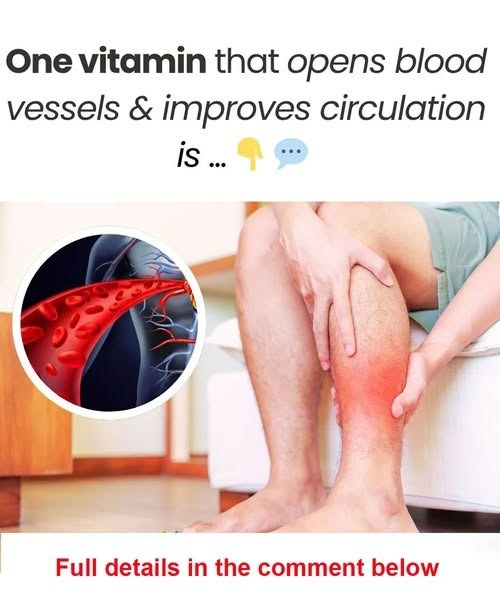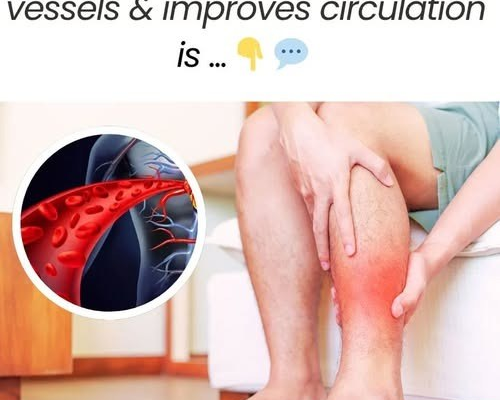Niacin After 50: The Circulation-Boosting Vitamin That Could Change Your Health
As we age, especially after turning 50, many people begin to notice subtle yet concerning changes in their circulation. Cold hands and feet, leg cramps, slow wound healing, and even fatigue during daily walks can all be early warning signs of poor blood flow. Left unchecked, these symptoms may lead to serious cardiovascular issues. Fortunately, science is revealing that one often-overlooked nutrient may offer an effective, natural solution: niacin, also known as vitamin B3.

Why Circulation Matters More After 50
After age 50, our cardiovascular system begins to lose some of its youthful flexibility. Arteries may become stiffer, veins less efficient, and blood vessels more prone to inflammation and damage. These changes can increase the risk of high blood pressure, heart disease, peripheral artery disease (PAD), and stroke.
Lifestyle factors—like sitting for long hours, lack of physical activity, smoking, or poor diet—only add fuel to the fire. That’s why improving blood flow isn’t just about comfort—it’s a critical part of maintaining independence and overall health in later years.
Niacin’s Powerful Role in Vascular Health
Niacin is a water-soluble B vitamin that plays a central role in cardiovascular function. Its benefits go far beyond simple nutrition. Here’s how it helps:
- Expands blood vessels: Niacin stimulates the production of nitric oxide, a compound that relaxes and widens blood vessels, improving circulation—especially to the legs and extremities.
- Reduces inflammation: Chronic inflammation is a root cause of vascular aging. Niacin helps soothe blood vessels, reducing the risk of damage and blockage.
- Repairs vascular cells: It supports the health of the endothelium, the thin layer of cells lining arteries and veins, promoting elasticity and resilience.
- Improves lipid profiles: Niacin has been shown to significantly lower triglycerides and raise HDL (“good”) cholesterol by as much as 15–35%, helping to prevent plaque buildup.
These combined effects make niacin a valuable ally for aging adults looking to maintain or restore healthy blood flowand protect against dangerous vascular conditions.
Breakthrough: Niacin and Leg Circulation
A recent innovation in niacin research involves a form of vitamin B3 called nicotinamide riboside (NR)—a more bioavailable version that may offer enhanced benefits with fewer side effects. In one study, patients with peripheral artery disease (PAD)—a condition that narrows arteries in the legs—saw improved mobility and muscle repair after supplementing with nicotinamide riboside.
This is especially promising for older adults who experience leg fatigue, pain while walking, or cold feet, symptoms often linked to reduced circulation. The potential of NR to boost energy production in muscle cells and accelerate tissue recovery could mark a turning point in how we approach age-related vascular decline.
Natural Sources of Niacin
While supplements are available, many people can get enough niacin through a well-balanced diet. Good sources include:
- Lean meats and poultry – like chicken, turkey, and beef
- Fatty fish – such as salmon and tuna
- Whole grains – brown rice, oats, and fortified cereals
- Legumes and seeds – sunflower seeds, peanuts, lentils
- Avocados and mushrooms – nutrient-dense plant sources
Your body can also produce niacin from tryptophan, an amino acid found in protein-rich foods like dairy, eggs, and turkey. However, this conversion requires sufficient intake of vitamin B2 (riboflavin) and vitamin B6 (pyridoxine)—yet another reason why a balanced, nutrient-rich diet is vital as we age.
Caution: Use Niacin Supplements Wisely
While niacin supplements can offer powerful benefits, they aren’t without risks. High doses—particularly from nicotinic acid, the flush-producing form of niacin—can cause:
- Facial flushing and itching
- Nausea or upset stomach
- Liver toxicity, especially with extended use
It’s essential to consult your healthcare provider before starting niacin supplementation, especially if you’re on cholesterol medications, have liver issues, or are managing chronic conditions. In some cases, extended-release niacin formulations may be safer and better tolerated.
The Bottom Line
Niacin is much more than just another vitamin—it’s a circulation-boosting powerhouse, especially valuable after the age of 50. By supporting vascular health, reducing inflammation, and improving cholesterol, niacin helps address some of the most pressing health concerns in aging adults.
With emerging evidence around nicotinamide riboside and its muscle-repairing benefits, this nutrient continues to reveal new potential for supporting healthy aging. Whether through whole foods or supplements (under supervision), adding niacin to your wellness strategy could be a small change with major long-term rewards—especially for your heart, your legs, and your overall vitality.


